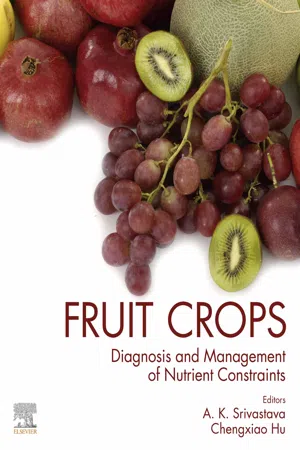
Fruit Crops
Diagnosis and Management of Nutrient Constraints
- 776 pages
- English
- ePUB (mobile friendly)
- Available on iOS & Android
About this book
Fruit Crops: Diagnosis and Management of Nutrient Constraints is the first and only resource to holistically relate fruits as a nutritional source for human health to the state-of-the-art methodologies currently used to diagnose and manage nutritional constraints placed on those fruits. This book explores a variety of advanced management techniques, including open field hydroponic, fertigation/bio-fertigation, the use of nano-fertilizers, sensors-based nutrient management, climate- smart integrated soil fertility management, inoculation with microbial consortium, and endophytes backed up by ecophysiology of fruit crops. These intricate issues are effectively presented, including real-world applications and future insights.- Presents the latest research, including issues with commercial application- Details comprehensive insights into the diagnosis and management of nutrient constraints- Includes contributions by world renowned researchers, providing global perspectives and experience
Frequently asked questions
- Essential is ideal for learners and professionals who enjoy exploring a wide range of subjects. Access the Essential Library with 800,000+ trusted titles and best-sellers across business, personal growth, and the humanities. Includes unlimited reading time and Standard Read Aloud voice.
- Complete: Perfect for advanced learners and researchers needing full, unrestricted access. Unlock 1.4M+ books across hundreds of subjects, including academic and specialized titles. The Complete Plan also includes advanced features like Premium Read Aloud and Research Assistant.
Please note we cannot support devices running on iOS 13 and Android 7 or earlier. Learn more about using the app.
Information
Fruits and nutritional security
b Department of Food Sciences, Cholistan University of Veterinary & Animal Sciences, Bahawalpur, Pakistan
c Department of Animal Sciences, CVAS-University of Veterinary and Animal Sciences, Jhang, Pakistan
* Corresponding author: [email protected]
Abstract
Keywords
1 General
Table of contents
- Cover image
- Title page
- Table of Contents
- Copyright
- Contributors
- Editors’ biography
- Preface
- Chapter 1: Fruits and nutritional security
- Chapter 2: Nutrient density of fruit crops as a function of soil fertility
- Chapter 3: Nutrient redistribution in fruit crops: Physiological implications
- Chapter 4: Plant nutrition and physiological disorders in fruit crops
- Chapter 5: Ecophysiology of fruit crops: A glance at its impact on fruit crop productivity
- Chapter 6: Estimating carbon fixation in fruit crops
- Chapter 7: Effects of climate change on fruit nutrition
- Chapter 8: NIR spectroscopy and management of bioactive components, antioxidant activity, and macronutrients in fruits
- Chapter 9: Role of sensors in fruit nutrition
- Chapter 10: Omics in fruit nutrition: Concepts and application
- Chapter 11: Leaf analysis as diagnostic tool for balanced fertilization in tropical fruits
- Chapter 12: Diagnosis of nutrient composition in fruit crops: Major developments
- Chapter 13: Floral analysis in fruit crops: A potential tool for nutrient constraints diagnosis
- Chapter 14: Calcium nutrition in fruit crops: Agronomic and physiological implications
- Chapter 15: Boron deficiency in fruit crops
- Chapter 16: Boron toxicity in fruit crops: Agronomic and physiological implications
- Chapter 17: Aluminum toxicity and fruit nutrition
- Chapter 18: The importance of selenium in fruit nutrition
- Chapter 19: Importance of silicon in fruit nutrition: Agronomic and physiological implications
- Chapter 20: Cover cropping for increasing fruit production and farming sustainability
- Chapter 21: Rootstock: Scion combinations and nutrient uptake in grapevines
- Chapter 22: Microbial ecology in sustainable fruit growing: Genetic, functional, and metabolic responses
- Chapter 23: Mycorrhizosphere of fruit crops: Nature and properties
- Chapter 24: Mycorrhizas in fruit nutrition: Important breakthroughs
- Chapter 25: Microbial consortia: Concept and application in fruit crop management
- Chapter 26: Biofertigation in fruit crops: Concept and application
- Chapter 27: Nutrient management in fruit crops: An organic way
- Chapter 28: Biodynamic soil fertility management in fruit crops
- Chapter 29: Manipulating fruit quality through foliar nutrition
- Chapter 30: Open field hydroponics in fruit crops: Developments and challenges
- Chapter 31: Role of biochars in soil fertility management of fruit crops
- Chapter 32: Physiological and molecular basis of salinity tolerance in fruit crops
- Chapter 33: Salt stress alleviation through fertilization in fruit crops
- Chapter 34: Trunk nutrition in fruit crops: An overview
- Chapter 35: Importance of nanofertilizers in fruit nutrition
- Chapter 36: 4R nutrient stewardship in fruit crops
- Chapter 37: Climate-smart integrated soil fertility management in fruit crops: An overview
- Chapter 38: Evaluation of organic versus conventional nutrient management practices in fruit crops
- Chapter 39: Role of controlled and slow release fertilizers in fruit crop nutrition
- Chapter 40: Diagnosis and management of nutritional constraints in berries
- Chapter 41: Soil fertility: Plant nutrition vis-à-vis fruit yield and quality of stone fruits
- Chapter 42: Diagnosis and management of nutrient constraints in papaya
- Chapter 43: Diagnosis and management of nutrient constraints in mango
- Chapter 44: Diagnosis and management of nutrient constraints in bananas (Musa spp.)
- Chapter 45: Diagnosis and management of nutrient constraints in litchi
- Chapter 46: Diagnosis and management of nutrient constraints in pomegranate
- Chapter 47: Diagnosis and management of nutrient constraints in grape
- Chapter 48: Diagnosis and management of nutrient constraints in guava
- Chapter 49: Diagnosis and management of nutrient constraints in citrus
- Chapter 50: Diagnosis and management of nutrient constraints in pineapple
- Index